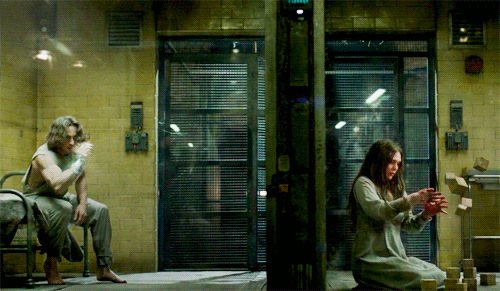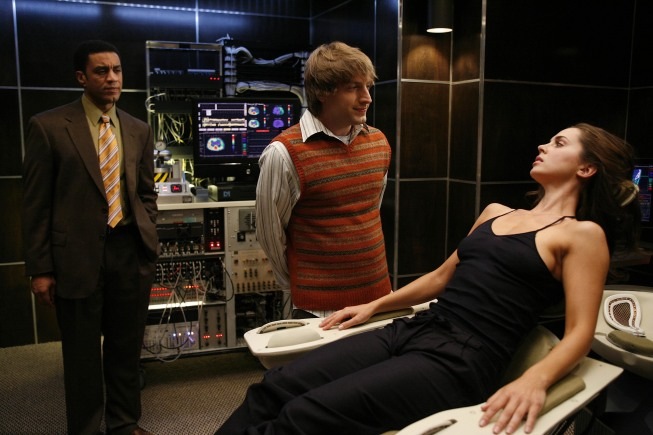From the first trailer for Avengers: Age of Ultron, with its creepy rendition of Pinocchio’s “I’ve Got No Strings,” we know that Ultron seeks to free himself, and the human race, from the physical and metaphorical strings holding them down. But while he delights in the fact that, upon achieving artificial intelligence and something approaching the Singularity, “there are no strings on me,” there are still switches. Throughout the movie, characters (both good and bad) and plot developments are activated through the use of code words or literal buttons.
In fact, for the past ten years and more, in almost all of his properties, Joss Whedon has placed entire dramatic arcs around a switch being thrown. Sometimes it serves simply as a deus ex machina, but on other occasions, Whedon has used the trope to explore issues of control and ownership, over both men and women.
Spoilers for Avengers: Age of Ultron.
While discussing the movie with friends and coworkers, I kept getting stuck on how the Avengers regulate Bruce Banner’s transformations into the Hulk and his subsequent behavior. After the first “look how well we all fight together” sequence, Black Widow tracks Hulk down in the woods to “sing him a lullaby.” It’s all code words—“hey big guy” and “the sun is getting real low”—accompanied by a specific series of mirroring hand gestures. It’s not too much of a leap to guess that Natasha had already picked up these kinds of methods in her own Widow training, and there’s no doubt Tony came up with the sarcastic name. But let’s not forget the fact that Bruce Banner probably also helped set up the lullaby! Since The Avengers, we’ve seen him desperate to work with the Other Guy, to figure out a way to have a regulated “Code Green” instead of the unharnessed “Hulking out” of comic book canon. So when Natasha holds out her hand, it works: the Hulk shrinks back into a shivering Bruce.
Where a switch can change a being’s physical state, it can also give life. Both Ultron and Vision are created from scratch, with very clear moments in which each is switched on. After enough countless tries to make Tony and Bruce turn away from their lab, Ultron activates himself, rising out of the alien code and overwhelming J.A.R.V.I.S. We later learn that J.A.R.V.I.S. escaped into the Internet—as Ultron has done, to jump into multiple bodies all over the world—and is recovered to create Vision. And it’s a group effort that brings Vision to life, in a complicated switching-on process: Ultron preps the vibranium body (buit by Dr. Cho) to house his consciousness; Natasha successfully steals the body, sending it back to Avengers Tower with Clint; Tony uploads the reconstructed J.A.R.V.I.S. into the shell body; and Thor goes all Dr. Frankenstein with Mjolnir-summoned lightning for the final spark.

Vision is the only being who seems able to “switch off” Ultron—first by cutting him off from the Internet, thus reducing him to controlling only the bodies in Sokovia; then later, by wiping out the final Ultron drone. And yet, with all this power, Vision is the only character in the film without any sort of “off” switch! Unless, of course, someone decides they have to yank out the Mind Stone for the fight with Thanos over the Infinity Gauntlet. It will be interesting to see how Vision, who seems to possess neither ego nor selfish impulses, will react if it comes to that.
A subtler but no less relevant example of the “on” switch in Age of Ultron lies with the Maximoff twins. As Wanda tearfully lays out their origin story to Ultron, a bomb killed their parents but missed them. For two days, they lay in the rubble beside another bomb that didn’t go off—one that said STARK INDUSTRIES on the side. Those harrowing two days were what activated them, even before they volunteered for Baron von Strucker’s experiments to give them super-speed and the ability to warp minds.

Similar to the bomb that “creates” the Maximoffs, Ultron’s big plan involves another sinister switch just waiting to be thrown: He uproots part of Sokovia’s city, turning it into a meteor with enough force to effectively reboot the Earth. Considering how Ultron was created, it’s no wonder that he thinks in such black-and-white terms.
But part of why his plan doesn’t succeed illustrates the problem with a switch: Anyone can throw it, which means it can be used against its original creator. Though Ultron manages to drop the Sokovia meteor, the Avengers already have a plan in place to evacuate the city and then blow the abandoned rock into small, harmless bits.
Age of Ultron employs switches as several key plot points, but to return to the point of this essay: What most interests me is when Whedon embeds switches into people.
I couldn’t help but think of a very popular Whedonesque sleeper agent: Firefly’s River Tam, who starts out as seemingly just a damaged lab experiment. By the time we reach Serenity, however, an innocuous commercial for Fruity Oaty Bars triggers River’s latent sleeper agent programming, turning her into a killing machine who can be felled only by a certain word—which her brother Simon always knew but had never shared with the rest of the crew.

Or do I mean Dollhouse’s Echo, the blank “Doll” who is imprinted with entire personalities so that she can fulfill her clients’ fantasies? While at first the Dolls are presented as mere playthings for the rich and powerful, the technology that makes them possible is much more sinister. In fact, there’s a lot of foreshadowing to their true purpose—as soldiers and slaves—with the conditioning that “activates” them. Whenever Echo gets imprinted with a new personality, she has the same exchange:
Echo: Did I fall asleep?
Topher: For a little while.
Echo: Shall I go now?
Topher: If you’d like.
And to lead a Doll back to the lab to be wiped, all a handler has to say is, “Would you like a treatment?”
These women exemplify some of Whedon’s better feminist commentary—presenting female characters who initially appear to be property, empty shells, blank slates on which others’ desires can be written. But in every case, the original character is never entirely erased, and must fight through layers of programming and other blocks to regain her identity.
But several of Whedon’s male characters also have their own triggers. In season 7 of Buffy the Vampire Slayer, the First programs Spike to turn violent when he hears the song “Early One Morning.” It was the song his mother used to sing him, but it does the opposite of the Hulk’s lullaby: It turns him violent and soulless, as he relives the awful memory of turning his mother into a vampire and her then rejecting him.
We knew even back in The Avengers that Bruce had some control over his alter ego: One of the most character-affirming moments in the movie was Bruce revealing that “I’m always angry” before seamlessly transforming into the Hulk and punching a Chitauri in the nose. That’s why I personally disliked the moment in Age of Ultron, when Natasha decided she needs the other guy in the final battle: She kisses Bruce and then shoves him into a pit, trusting that the Hulk will bounce right back up.
I felt that that moment delegitimized Bruce’s tenuous control over his character. However, it led into an important development, which was watching the Hulk take control of himself after the battle. When given the chance of dropping into one of S.H.I.E.L.D.’s stealth Quinjets, he turns off Natasha’s communication link and goes AWOL.
The turning point with this trope is when passive becomes active—when sleeper agents go from being at the mercy of a code word to controlling that transformation themselves.

After River’s freakout in Serenity, the rest of the crew—who had come to regard her nearly as family—go back to distrusting her, back to believing that she is a ticking time bomb. However, during the final battle against the Reavers, what “triggers” River is watching Simon get cut down. No subliminal advertising, no whispered command—she picks up a battle axe, closes the blast doors to protect the rest of the crew, and goes to town on the Reavers. Over the course of Firefly, we saw her access her own programming in small ways as she became increasingly self-aware about who she was. But here is the first time that she truly controls herself as a weapon.
Same with Dollhouse: While the Dolls begin the series passively climbing into the chair to be imprinted with a personality, by the end, they’ve taken the process into their own hands. Literally: We see certain factions of Dolls cherry-picking skills (language, fighting, etc.) from personality wedges, constantly adding and replacing different skillsets depending on the situation. Then there’s Echo, who accepts her Doll state as a legitimate being but still takes on more and more personalities as situations call for them.
Spike, too, rejects his trigger. Once he is forced to listen to “One Early Morning” and face the entire memory, Spike overcomes his regret and regains control of himself.
While Whedon returns again and again to the trope of characters who exist at the mercy of someone else’s switch, they share the same narrative: They learn to control their own switches, to turn on and off the monster or weapon. In The Avengers and Age of Ultron, we see Dr. Bruce Banner employ various methods to activate and deactivate his alter ego. It’s clear that when Natasha starts the lullaby, it’s Bruce she’s trying to reach. But by the end of the film, we watch the Hulk begin to become more self-aware. I think that’s why he disappears—to find his quiet place, and a way to switch himself off.
Natalie Zutter wants you to know that there are three flowers in a vase. The third flower is green. You can read more of her work on Twitter and elsewhere.











I felt that that moment delegitimized Bruce’s tenuous control over his character.
I disagree with this, because it was established even back in Avengers, that despite his “I’m always angry” control, that control could be usurped by things that threaten Bruce. The Other Guy comes out, as Tony says, to save Bruce’s life. Yes, Bruce can bring him out when his life isn’t in jeopardy, but if his life or safety is at risk, the Other Guy’s coming whether Bruce wants him to or not.
Now, I do feel that Tasha usurped that control, which isn’t a cool thing to do, ESPECIALLY to a potential romanctic partner. I mean there are ALL KINDS of consent issues here.
Fantastic article! I’ve always been fascinated with mind control and psychology in storytelling, and even I didn’t realize this common thread running through Whedon’s work.
You know I did sense something familiar with that sequence and it took your article to remind me that I was remembering Dollhouse
I recognize that this is something that Whedon likes to come back to–they were present in his Astonishing X-Men run. I think with the Hulk, though there is an important difference–the ‘switch’ is not external. The Hulk isn’t even external; Bruce Banner IS the Hulk. He is a man divided against himself, but he is not really two different people.
This is the shame and fear of the Hulk, and why he is a powerful pop culture figure: he represents a fear that we don’t really control our own emotions or actions. They just HAPPEN. External factors might trigger the fear and anger that turn Bruce Banner into the Hulk, but at the end of the day he owns that fear and anger. It is a part of him. And he finds it exhilarating and empowering, and he is also deeply ashamed of that side of him. So when he says that he’s always angry in the Avengers, it’s not that he is asserting control over the force within him: he is acknowledging, for a just a moment, that it is him.
In the context of Age of Ultron, Black Widow and Bruce Banner didn’t play a trick on the Hulk to tame him. He’s never really tamed, he’s always there. Rather, she has a relationship with the man, whether he is Bruce Banner or the Hulk.
@@.-@, IMO, it’s tied to that gentle contact. Who has ever touched the Hulk? When Hulk is out, it’s always about violent contact.
Getting him to stop and focus is only part of it, it all hinges on that gentle caress.
LOVE the Dollhouse reference in the signature, Natalie.
I also liked the parallels with Scarlet Witch, both the moment she steps out the door, very empowered, perhaps reminded me of River, and her tearing out the whatever from the main Ultron body–very Primeval Buffy.
@@@@@ 4 – THANK YOU COLIN! What an excellent discussion of the Hulk/Banner “split”!